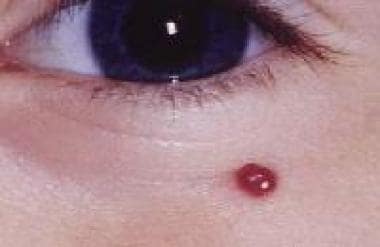How do you treat pyogenic granulomas ?
PYOGENIC GRANULOMAS :
Pyogenic granulomas are skin growths that are small, round, and usually bloody red in color. They tend to bleed because they contain a large number of blood vessels. They’re also known as lobular capillary hemangioma or granuloma telangiectaticum.
The name pyogenic granuloma is actually inaccurate. Pyogenic means pus-producing, and a granuloma is a cluster of white blood cells reacting to infection, causing a lump. Pyogenic granulomas are rarely related to infection, and they don’t generally contain white blood cells or pus. The condition is more accurately called lobular capillary hemangioma, a tumor consisting of abnormal blood vessels.
A pyogenic granuloma is a noncancerous, raised tumor on your skin or mucous membranes. They’re often associated with pregnancy, medications and injury to your skin or membranes. The lesions, made of abnormal blood vessels, break and bleed easily. Several medications and procedures can help, but lesions might come back or appear in other areas.
WHAT ARE THE CAUSES OF PYOGENIC GRANULOMAS ?
It’s not always clear what causes a pyogenic granuloma. These growths can occur after injuries, but the reason for this isn’t known. Other causes of pyogenic granulomas include trauma caused by bug bites or by scratching your skin roughly or frequently.
The hormone changes your body goes through during pregnancy can also cause pyogenic granulomas. Certain medications can also lead to this condition. These medications:
- indinavir (Crixivan)
- isotretinoin (Accutane)
- acitretin (Soriatane)
- some birth control pills
Pyogenic granuloma is treated depends on its size and location:
Small pyogenic granulomas
You might not need treatment for small pyogenic granulomas. These often go away on their own.
Large pyogenic granulomas
If you have a bigger growth, your doctor will most likely shave it off and lightly cauterize or burn it. Cauterizing helps stop bleeding and can reduce the risk of it growing back.
According to the AOCD, the most effective way to remove pyogenic granulomas involves surgically removing the entire growth and using stitches to close the wound. This is a more invasive procedure than scraping one off. A pyogenic granuloma will usually be surgically removed if it’s recurred once after a nonsurgical approach.
Alternatively, your doctor might apply a chemical, such as silver nitrate, to the pyogenic granuloma to help with the bleeding.
These growths can also be removed using laser surgery.
Don’t pick at the granulomas or try to remove them on your own. They tend to bleed for a long time, so having a doctor remove them with proper instruments and cautery tools is a must.
Pyogenic granulomas on the eye
Pyogenic granulomas that grow on your eye can be surgically removed or treated with ointments containing corticosteroids. These help reduce inflammation.
Pyogenic granulomas during pregnancy
If you’re pregnant, your doctor might recommend waiting to see if these growths disappear on their own after delivery. A decrease in hormone levels may help the lesion regress on its own. Ultimately, this approach is the safest for the growing fetus.
Developing treatments
Researchers are studying noninvasive treatments for pyogenic granulomas, particularly for children. A topical medication called timolol applied as a gel to the nodule is effective at treating the lesion without negative side effects.
Topical medications applied to your skin to shrink pyogenic granulomas include:
- Chemicals such as silver nitrate phenol and trichloroacetic acid (TCA).
- Eye drops such as timolol for a granuloma in your eye.
- Imiquimod skin cream.
- Steroid injections into the lesion.
Procedures that can remove granulomas include:
- Cryotherapy, to freeze it away.
- Curettage, to scrape it away, and cautery, to seal the skin with heat.
- Laser treatment to destroy the abnormal tissue.
- Surgical excision, to cut the granuloma out of your skin.


Comments
Post a Comment